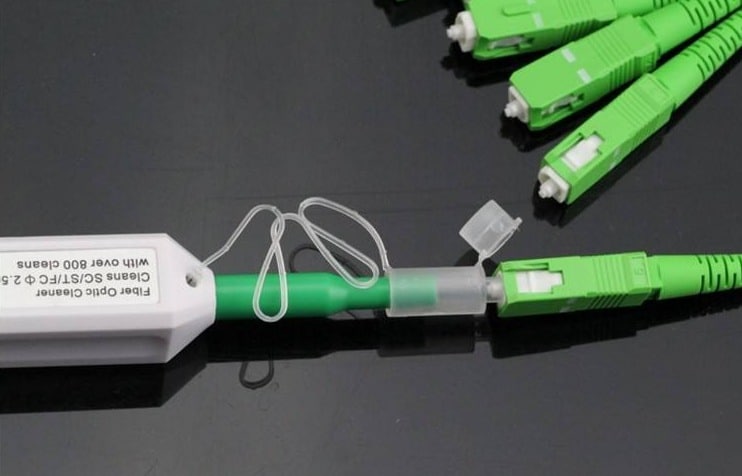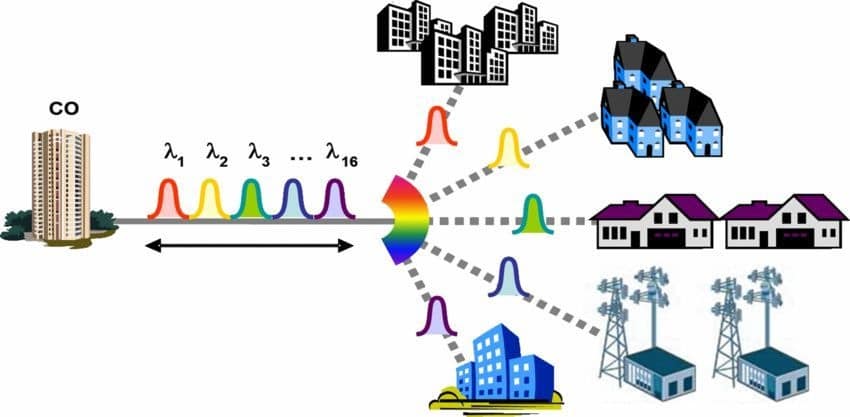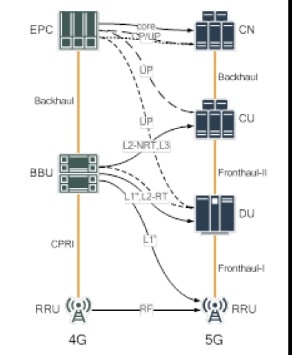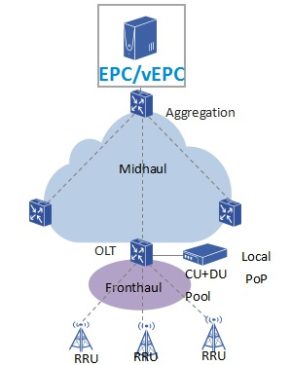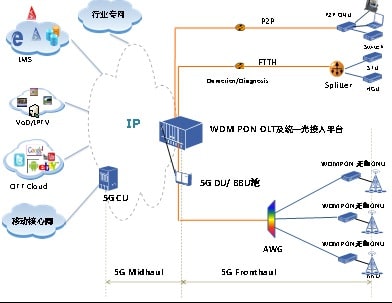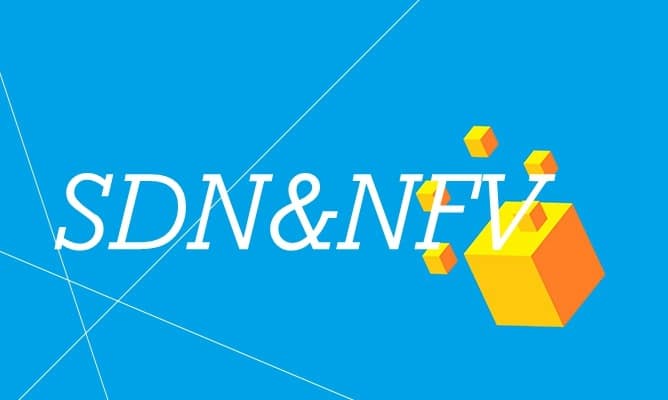
Recently, there have been rumors that China Telecom and China Unicom are about to merge. Foreign media speculate that the merger of the two operators is to accelerate the launch of 5G. Although the subsequent merger rumors have been denied by both China Unicom and China Telecom, the rise of new concepts and technologies such as 5G, SDN and NFV is profoundly affecting the network communication market and promoting the market participants in the technical architecture and organizational system represented by operators. Rapid changes, in the current diversified user needs, the transformation and reconstruction of the global network is the trend and unstoppable.
If the arrival of 5G is the catalyst for the merger of operators, then SDN/NFV is the only way for operators to move toward transformation. It is foreseeable that a new era of the network is coming soon. Domestic and foreign operators have laid out SDN and NFV in order to adapt to the trend and self-innovation and win more development space.
It is no accident that operators introduce SDN and NFV
With the scale of emerging information technology business applications such as cloud computing and big data, the demand for new business applications is increasing, flexibility, scalability, and ease of use become the basic capabilities that operators must have in their future networks. The ability to self-service virtual networks on demand will be the key to future networks. Therefore, the emergence of SDN and NFV technology has quickly become the focus of operators.
SDN, a software-defined network, which was born on the campus network, is a network virtualization (NV) technology that uses standard protocols (such as OpenFlow) to separate the control plane of network devices from the data plane. Software implementation. NFV, the virtualization of network functions, was created by service providers to enable flexible network capabilities through IT virtualization technology, using industry-standard high-capacity servers, storage and switches to carry a wide range of network software functions. Configuration to improve the uniformity, generalization, and adaptability of network devices, speed up network deployment and adjustment, and reduce the complexity of service deployment.
SDN provides the management and orchestration tools needed for increasingly complex and highly virtualized networks. For operators, SDN can create efficiencies associated with spectrum and network resource allocation, as well as manual levels of operation directly related to labor costs. For operators of enterprise services, SDN brings the inherent flexibility and scalability that companies need to benefit from creating new services.
According to the definition of ETSI, NFV aims to change the way network operators build networks by developing standard IT virtualization technologies. Compared to networks built with traditional network equipment, NFV will provide a high-performance network with greater scalability, resiliency and adaptability at a lower cost. NFV is a highly complementary SDN. NFV can reduce operators’ CAPEX and OPEX by reducing equipment costs and reducing power consumption. NFV also reduces deployment time and provides greater flexibility to scale or shrink services.
The emergence of SDN and NFV can well (or most promisingly) solve the dilemma faced by current network (telecom) operators – such as poor network flexibility, high networking costs, complex management, large operation and maintenance, new Business is slow and so on.
Carrier SDN/NFV road, development, and challenges coexist
At present, almost all major operators, equipment vendors, and Internet companies all over the world are conducting research and deployment of SDN/NFV. Major international organizations are also making efforts to promote the development of relevant standards, but SDN/NFV is still in the initial stage of technology application. The large-scale application of the carrier network also faces many challenges.
The first is the challenge of operations and talent. SDN/NFV has a great impact on the telecom operation system. It is difficult for the operator’s existing operating system and human resources to adapt to the SDN/NFV network operation requirements;
The second is the networking and technical challenges. As far as SDN is concerned, the main challenges at present are concentrated on networking problems of SDN controllers in large networks, security issues of SDN controllers, standards and interworking, and performance of IT hardware devices. Specifically:
1. Challenges faced by interface/protocol standardization. The SDN standardization organization ONF emphasizes that OpenFlow is no longer the only southbound interface, and the northbound interface is mainly RESTful. Each interface is implemented by means of IT ideas and using models/templates. Manufacturers only need to publish their own models to achieve interoperability. control. Both VMware and OpenStack are implementation systems of SDN in the application layer. They are independent of each other and have advantages, such as Android and IOS for mobile operating systems. Therefore, whether the SDN standard system can be unified or not is still controversial. .
2. Security challenges. As the implementation part of the centralized control of the network, the core controller of the SDN network may have security problems such as excessive load, single point failure, and vulnerability to network attacks. This requires establishing a complete set of isolation, protection, and backup mechanisms to ensure the entire system. Safe and stable operation. But for now, there is still a lack of systematic solutions.
3. The control architecture system of SDN centralized control concept is not unified. The division of the control architecture hierarchy and the composition of the control plane need to be further studied and clarified. It is very important that the SDN control plane grasps the resources of the global network. The performance of the control plane directly affects the performance of the overall network. Networks in different professional categories need to be composed of professional and general purpose controllers as needed. In the implementation of the controller, there are cases where the hierarchical structure of the controllers in different domains of the network is different. For example, the mobile core network adopts a three-layer architecture and the data center adopts a single-layer architecture. At present, there are many options for the southbound interface, such as OpenFlow, BGP, SNMP, etc. The northbound interface can select different interfaces according to different scenarios, and there is no unified consensus on the east-west interface that has just been researched.
For many operators, large-scale deployment of NFV is very complicated and difficult. The breadth of architecture and the number of different components make the design, build, and support extremely challenging. The NFV must be integrated into the existing network infrastructure and linked to the operating system. Lack of mature standards and “blueprints” for NFV implementation will continue to hamper deployment. With labs, proof of concept, field trials, and comprehensive solutions in production networks, it can take years to complete an NFV deployment.
NFV involves a variety of technologies that are still evolving. Most of them are different from telecom operators. Operators who can leverage enterprise/IT departments with cloud experience will have an advantage in implementing NFV, but even if they find it difficult to keep up with the pace of change. Cloud technology needs to be fully implemented, not sequential or only partially, which complicates the challenge.
NFV operations are fundamentally different from traditional network operations. Operators must borrow a large amount of IT during design operations and make telecom-specific adjustments. The pioneers of NFV operations are taking their own path. They are developing proprietary features and rotating them regularly to address their concerns. This has led to fragmentation and uncertainty in the markets of suppliers and other operators that require a “standard” blueprint.
The development of future information will be oriented to the cloud computing network with SDN/NFV as the core. At present, the structure of the telecom network architecture has been affected by the virtualization and software of the network. Operators are faced with standardization, device development and application deployment. challenge.
Status of SDN and NFV deployment of operators at home and abroad
SDN and NFV have been hot topics in the telecommunications industry for many years, but there are still significant differences between speculation levels and actual real-time deployments. It is predicted that the growth rate of global telecom operators will slow down in the next few years. In particular, the growth of mobile services that will drive operators’ revenue this year will also usher in the ceiling. The mode of relying solely on investment to drive growth will be difficult. The following is an inventory of the status of SDN and NFV deployments of domestic and foreign operators.
AT&T was an early promoter of the Domain 2.0 NFV/SDN program, which evolved into Enhanced Management, Control, Orchestration and Strategy (ECOMP) software. ECOMP was later integrated with Huawei’s OPEN-O software and then offered as open source software through the Linux Foundation under the new name Open Network Automation Platform (ONAP). In a post on the AT&T Innovation Blog in March this year, Chris Rice, senior vice president of architecture and design for Domain 2.0, noted that the carrier achieved 55% of network virtualization and software control in 2017 and plans to ship the software by 2020. The control rate is increased to 75%, reaching the “core network function.” He also plans to link the commercialization of 5G with the need to deploy SDN and NFV on the network.
In 2016, China Telecom announced the CTNet2025 program, hoping to create a new network that is simple, agile, open and intensive in about 10 years. After almost two years, China Telecom has achieved certain results in the technical exploration and application deployment of SDN and NFV. In terms of SDN technology, China Telecom is based on a self-developed collaborative orchestration system, which ensures the end-to-end capability of the network through the orchestrator in cooperation with controllers of different vendors and compatible with various network protocols of the existing network. In terms of NFV technology, China Telecom adhered to the requirements of deep decoupling deployment, and independently developed two key components such as NFVO and VIM in MANO system, which promoted NFV to the existing network.
China Mobile has joined ONF in SDN in 2013. It has made important contributions in the areas of SDN architecture, carrier applications, OpenFlow standards, information model development, data center/transport network, etc. Mobile requirements for SDN, technical frameworks, interface specifications, etc. are written to relevant standards. In addition, China Mobile led the establishment of the Carrier-Grade SDN Working Group to promote the application of SDN in the carrier network. At the same time, CCSA is also an important position for China Mobile to promote SDN standardization. China Mobile has participated in the formulation of multiple standards such as architecture, data center, and vBRAS. In terms of NFV, China Mobile took the lead in setting up the OPEN-O open source organization in 2016 and released the SUN version in November 2016. The SUN version created the de facto Stage3 standard based on the MANO interface of IETF Stage2, which was developed for the IETF Stage3 MANO standard. It laid the foundation. In addition, China Mobile also promoted the development of NFV-related standardization in CCSA and led the establishment of various standards including overall technical requirements, MANO, and hardware.
In order to seize the technological change opportunities brought by SDN/NFV, China Unicom has launched the CUBE-Net 2.0 strategy and is more proactive in responding to its challenges to operators. On the one hand, China Unicom actively participates in relevant standards organizations such as ITU, 3GPP, ETSI NFV, IETF, and actively participates in open source communities such as OPNFV and ODL. Especially in the board of directors of the two open source communities of ONOS and CORD, which are the only operators in China, work closely with all parties to promote the further maturity of standards and open source software. In addition, Unicom is actively working closely with large-scale mainstream equipment manufacturers to establish an SDN/NFV Innovation Center. At the same time, China Unicom also fed back the research and development and test results related to SDN/NFV to various industrial chains, and also promoted the development of related industrial chains.
Verizon is investing in NFV to reduce costs, increase network flexibility and agility, and reduce professional network operations staff. The company is building a common OpenStack platform for the company to run VNF (virtual network capabilities) and other internal applications. OpenStack components are being adapted to the needs of operators, and Verizon says they can now improve on high availability, SR-IOV and DPDK support, NUMA memory and scheduling, and SSD as a cache.
On SDN, Verizon is responding to the rapid migration of enterprise customers to the cloud and the growing demand for virtualization services in 2009. Verizon is integrating Versa Networks’ cloud IP platform into Verizon’s new software-defined security branch (SD-Branch) management. To expand its Software Defined Network (SDN) platform services. In 2018 Verizon and Colt used SDN Orchestration to control each other’s networks. In the same year, Verizon brought the SDN seed to the campus network structure in the wireless network, and launched its software wireless local area network (SD WLAN) for the first time, reflecting the development of the wireless ecosystem. Earlier this year, Verizon began offering software-defined networking (SDN) coverage, which is expected to continue until the end of next year. At that time, Verizon plans to manage all its edge routers by running centralized controller software on x86 servers. Cisco and Juniper Networks are helping to build the Verizon SDN infrastructure.
NTT Communications won the best NFV/SDN implementation and the most innovative IoT project at the 2018 Asia Telecom Awards. In NFV, NTT Communications hopes that the NFV platform will be able to combine NFV services between distributed heterogeneous sites. Mainly carrier networks, cloud and user sites. NTT Communications deployed a number of proofs-of-concept to build the same architecture and topology as the commercial ISP backbone and cloud services. NTT will introduce OpenStack-based VVF NFV services to its enterprise customers, including managed network features such as firewalls and load balancers. Customers can change their network topology by adding and separating VNFs.
Deutsche Telekom (DT) announced the development of an unattended network at the 2017 SDN NFV World Congress and urged the telecommunications industry to jointly develop a common approach to automation. The ultimate goal is to be able to run applications as microservices on their network and use automation to eliminate unnecessary complexity. In the same year, Deutsche Telekom joined the Open Network Foundation (ONF) as a formal partner. Deutsche Telekom (DT) is investing in OpenStack as a platform for NFV. With NFV technology, DT can quickly deploy and scale or scale virtual network functions without new investments in hardware. In March 2015, DT announced the first NFV workload to run OpenStack, a cloud VPN service available in Croatia, Slovakia, and Hungary.
SK Telecom focuses on the virtualization of traditional telecom network functions such as IMS and EPC for flexible scale-out and service traffic explosion control. These VNFs are used to provide customer-specific, dedicated multi-tenant telecommunications services by coordinating the service chain. VNF also improves service quality and reliability through resilient VNF resource management and load balancing control. SK Telecom’s network research and development center successfully deployed some of its IMS services as vIMS in OpenStack’s commercial operating environment and has successfully operated. Mobile operators will soon commercialize more of their IMS services into vIMS and put them into production. SK Telecom hopes to realize the advantages of NFV through OpenStack, reduce service downtime and costs, and improve network utilization through automation, creating more business opportunities through flexible and programmable infrastructure, enabling the company to target a variety of business and technology choices.
In 2017, SK Telecom created its own internal NFV MANO, which plans to first apply T-MANO to its virtual router for high-definition voice services. It then applies T-MANO to virtualized LTE and add-on devices, including multimedia messaging service (MMS) servers. SK Telecom has deployed virtual EPC in 80% of new EPC deployments. Starting in 2019, it will deploy only virtual EPCs in the network.
At the 2017 SDN NFV World Congress, KT demonstrated the commercialization of “SDN (Software Defined Network) Solutions” and “NFV (Network Function Virtualization) Solutions”. KT’s “SDN Solution” is a fully automated solution that works not only through dedicated line services but also on the network, IP and cloud services so that it can simultaneously control the entire ICT infrastructure. By converging automation and intelligence, SDN solutions can build a system that delivers on-demand service and instant failure recovery. In addition, KT’s “NFV Solution” is based on NFV technology, which allows real-time remote control through the use of virtualized switches, virtualized firewalls, VPNs, etc., to provide customers with a secure environment without the need for a network security administrator.
KT is currently developing a software-defined infrastructure with its own technology. Here, integrated core technologies such as KT SDN-based network virtualization, cloud computing, intelligent operation automation, etc. This year, KT plans to apply the SDN solution to KOREN, which was released at the 2017 SDN / NFV World Congress.
The history of the KT SDN solution:
- 2015: Launch of T-SDN at the 2015 SDN / NFV World Congress
- 2016: 2016 commercial T-SDN
- 2017: Full implementation of SDN / NFV transformation in 2017
- 2017-2020: Development of SDI and T-SDN, IP-SDN and controller layout for (at least) 100G UWB networks
Colt was the first to introduce services based on SDN and NFV technologies, and launched DCNet as a service product in October 2015, adding SD-WAN and Ethernet on-demand services in the following six months. On the technical side, Colt is currently deploying the “Packet SDN IQ Network.” Colt is also working on optical SDN technology with the goal of developing a “completely decomposed, software-controlled optical transport network.” This year Colt’s SDN program is being promoted in the Asia Pacific region, and Colt is now offering SD-WAN solutions in the Asia Pacific and North America, expanding from the European core. These SD-WAN features are combined with NFV services, and Colt provides services through universal CPE and access options from Colt’s own fiber to the third-party Internet to 3G/4G wireless links. The company has officially launched an on-demand network service at the Southeast Asia Center in Singapore.
In June 2018, BT announced the launch of a new software-defined wide area network (SD-WAN) management service using Cisco technology. The release further expands BT’s enterprise customers’ choice of Cisco-based software-defined networking (SDN) and network function virtualization (NFV) solutions.
BT Connect Cisco SD-WAN provides customers with a clear view of WAN traffic, enabling them to optimize traffic to meet business needs. BT also said it will further strengthen BT’s strategic partnership with Cisco. Just a few months ago, the company announced plans to add two new Cisco-based solutions to its portfolio: a customer office equipment virtualization solution managed by BT (BT Connect Edge) and another integration of BT and Cisco. Network automation and orchestration software platform for BT Connect Services platform. In addition to future versions of the Cisco program, BT will also invest in a functional plan for managed services.
CenturyLink has adopted a very different approach in its third-generation NFV/SDN deployment, which focuses on reducing the complexity of the network and enabling new services and infrastructure to be developed and expanded faster. CenturyLink’s first generation of virtualization was very simple, adding choreography to the second generation. CenturyLink’s NFV/SDN engineering team has been using agile software development methods to handle all infrastructure, not using traditional methods to integrate new things into old things, and they are working together to simplify software engineering and increase internal speed. Secondly, CenturyLink has implemented SDN in various parts of its network, and about 60% of the company’s core websites are running NFV and SDN services. And the company emphasizes the need to strengthen cooperation with traditional telecom providers in the NFV and SDN sectors, such as Ericsson, Cisco, ITE, etc.
Since its inception in 2014, Orange has been involved in the OPNFV project hosted by the Linux Foundation, contributing to the testing and interoperability of open NFV architecture, VNF/service entry, and operational simplification. Introducing Orange Easy GoNetwork, a Network as a Service (NaaS) offering for NFV use cases, Orange Business Services provides connectivity to branch offices or remote sites in 75 countries. At the 2017 SDN/NFV World Congress, Orange introduced their vCDN field trials, which successfully delivered live streaming video to their customers.
Comcast has joined the OpenDaylight project in 2015 to drive network automation and programmability for SDN and NFV. At the 2016 Open Network Summit, the company emphasized that Comcast has moved from a cable company to a network company. Comcast’s vision for SDN and NFV applications is:
- Overlay Networks: Comcast’s approach is to apply SDN technology to Overlay Networks, build L2/L3 VPNs for end customers, and use service chains to implement services, dynamically introducing network elements and extending them flexible.
- Network automation: The goal is that the network is programmable and intelligent while requiring minimal manual operations.
- Merchant Silicon: Focusing on Segment Routing while reducing the use of MPLS by leveraging commercial chips to simplify core and edge networks.
- Telemetry and Analysis: Apply big data and machine learning principles to software-defined networks and enable intelligent networks.
Altice partnered with Cisco in February 2017 to develop a long-term project to build the overall Network Function Virtualization (NFV) platform. By virtualizing key network capabilities, Altice will be able to accelerate time-to-market for new services worldwide. Altice’s French subsidiary SFR has been leading the transition to mobile packet core infrastructure, and its NFV platform architecture is designed to support multiple vendors. The SFR solution was designed by Cisco and Red Hat and is based on the Red Hat OpenStack platform, which combines Cisco’s networking, virtualization and data center computing solutions.
In February of this year, SFR said at the Mobile World Congress that it is deploying Cisco’s Network Service Coordinator (NSO). With Cisco NSO, SFR can gain the business benefits of SDN and intent-based networks, such as speed, flexibility, risk reduction, and continuity. Compliance and more.
In May 2017, Sprint announced the launch of C3PO, an open source NFV/SDN mobile core-based reference solution designed to dramatically improve the performance of the network core by providing a clean, simplified, high-performance data plane for the packet core. For NFV, Sprint is committed to deploying open source software on standards-based hardware to provide a more flexible, innovative and cost-effective network that supports ultra-high data speeds, ultra-low latency, and automated 5G requirements.
In September 2017, Sprint built a virtual core that replaced an independent bare metal platform with an NFV infrastructure (NFVI). The virtual core uses the operator’s Virtualization Evolved Packet Core (VEPC) and IP Multimedia Subsystem (IMS) as Virtual Network Functions (VNF).
Telecom Italia partnered with Juniper in 2014 to migrate its network to SDN/NFV technology. Telecom Italia will deploy Juniper’s MX Series 3D Universal Edge Router on its service PoP infrastructure. This solution will be used as a generic SND gateway to connect physical and virtual networks. Telecom Italia is also experimenting with Juniper’s Contrail SDN and NFV controllers and OpenStack, which is said to integrate virtual and physical network functions. In December 2015, Nokia Telecom Italy launched a global initiative to inject innovation into the telecommunications ecosystem. The two companies signed MoU on technology reconnaissance for innovative startups to identify potential partnerships in mutually agreed areas such as NFV, SDN, RAN Evolution, and next-generation SON. The goal of Telecom Italia is to continue to advance SDN and NFV technologies, build more NFV sites, virtualize its wireless access network and deploy NFV coordinators.
With its Unica strategy, Telefónica has been on the road to virtualization for more than four years and began implementing virtualization in its international network in early 2016, when it deployed Nokia’s virtual router technology. Telefónica uses four different Virtual Network Feature Providers (VNFs) to demonstrate its determination to pursue true multi-vendors. Huawei provides virtualization evolution packet core technology in Argentina and Peru, and ZTE launched virtualization IMS (Internet Protocol Multimedia Subsystem) in Peru. At the same time, Nokia announced on November 16 that it supported Unica’s virtualization service router, while Telefónica’s Colombian subsidiary is using Ericsson’s virtual IMS.
In May of this year, NETSCOUT announced that Telefónica has certified virtualization solutions vSCOUT and vSTREAM to deploy its UNICA Lab architecture to support future networks based on NFV/SDN technology.
Looking to the future
SDN/NFV is not only a technology driver but also the only way for operators. But in the face of the impact of traffic, the impact of new business, one side is the immature technology, the other side is the strong demand of the market, operators will sometimes be overwhelmed. But in any case, the market is demanding that operators must have more efficient and lower-cost operations.
SDN/NFV has a disruptive impact on the industry and within the company itself. However, operators can use this as an opportunity to reshape themselves from the aspects of the organization, product direction, technology reserve, and corporate culture.
Article source: https://www.sdnlab.com


